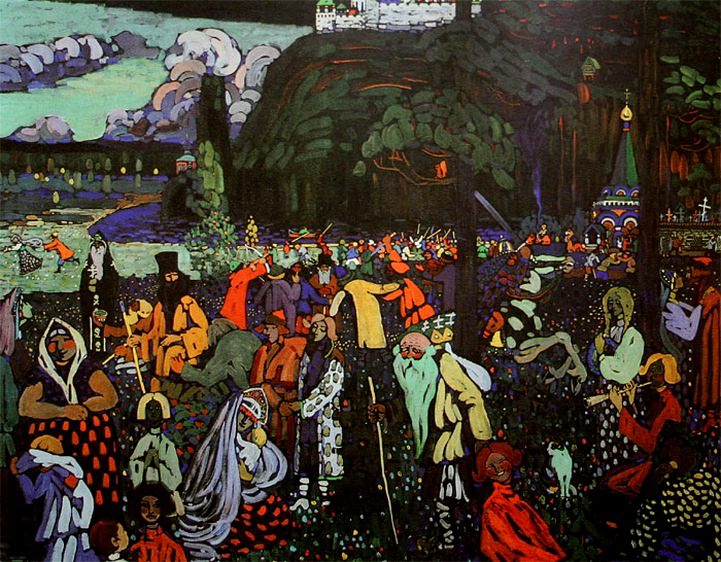Motley life Vasily Kandinsky (1866-1944)
Vasily Kandinsky – Motley life
Edit attribution
Download full size: 721×562 px (0,3 Mb)
Painter: Vasily Kandinsky
The Motley Life (La Vie melangee) is a painting by Wassily Kandinsky, one of the founders of abstractionism. After being purchased by the Bavarian State Bank, the painting has been on display in the city’s Lenbachhaus Gallery in Munich since 1972. Many art historians agree that "Motley Life" is considered one of the key works of the artist. It is a vivid hymn to Russian traditions - in contrast to the general desire of the tsar and the Russian elite to embrace Western culture. In 2017, it was revealed that the Kandinsky painting belonged to the Dutch Jewish Levenshtein family and had been illegally seized in 1940 after the German army occupied the Netherlands - a case of illegal Nazi looting.
Description of Wassily Kandinsky’s painting "Motley Life"
The Motley Life (La Vie melangee) is a painting by Wassily Kandinsky, one of the founders of abstractionism. After being purchased by the Bavarian State Bank, the painting has been on display in the city’s Lenbachhaus Gallery in Munich since 1972.
Many art historians agree that "Motley Life" is considered one of the key works of the artist. It is a vivid hymn to Russian traditions - in contrast to the general desire of the tsar and the Russian elite to embrace Western culture.
In 2017, it was revealed that the Kandinsky painting belonged to the Dutch Jewish Levenshtein family and had been illegally seized in 1940 after the German army occupied the Netherlands - a case of illegal Nazi looting. An application for restitution has now been filed in a U.S. court.
Wassily Kandinsky finished his group of colored drawings in Paris in 1907 with the very work "The Colorful Life". The love of bright life in the work of the young artist is combined with the influence of folk art. People in their bright costumes run like colorful living pictures on two legs.
Kandinsky shows here what constitutes human existence. A Russian matron takes a bite of an apple, a woman searching for tones on her flute. A couple of newlyweds want to kiss, a father-in-law shows his cross, and an old traveler is highlighted by his unexpectedly green beard. High above the clouds is a castle. It is absolutely impossible to understand from this painting how Wassily Kandinsky came from his objective early work to his abstractions, with which he revolutionized art history.
Кому понравилось
Пожалуйста, подождите
На эту операцию может потребоваться несколько секунд.
Информация появится в новом окне,
если открытие новых окон не запрещено в настройках вашего браузера.
You need to login
Для работы с коллекциями – пожалуйста, войдите в аккаунт (open in new window).




















You cannot comment Why?
This is Wassily Kandinskys painting Motley Life, created in 1907. It depicts a vibrant and chaotic scene of everyday life in a Russian village, brimming with people, animals, and architectural elements.
What I see:
The foreground is densely populated with a diverse array of figures. There are villagers in traditional Russian attire, including women with headscarves and colorful skirts, and men in hats and tunics. Some are engaged in work, like a man holding a shovel, while others seem to be conversing or simply existing within the bustling environment. Religious figures are also present, notably a man in a black religious hat and robes, suggesting the strong influence of faith in the community.
In the middle ground, the scene expands to reveal more activity. There are glimpses of animals, possibly horses and dogs, and further clusters of people moving about. The setting appears to be a countryside dotted with trees and patches of greenery.
The background features a dark, imposing hill covered in dense foliage. At its summit, a white, walled monastery with green-domed structures is visible, a prominent spiritual landmark. To the right, a blue and gold Orthodox church with a green dome stands amidst the trees, further emphasizing the religious context. The sky above is a dramatic expanse of turquoise and dark clouds, adding to the overall intensity of the scene. The overall impression is one of life in its full, unvarnished glory, a tapestry of human existence.
Subtexts and Interpretations: